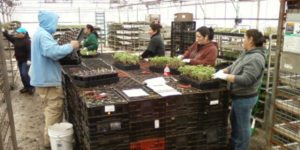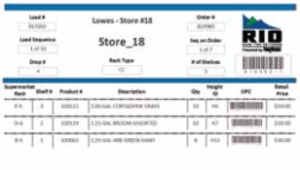Simplify Shipping with Lean Flow
As the green industry becomes more competitive and the margins get tighter, growers have to find ways to reduce their costs. One way many progressive growers are doing this is by implementing lean flow techniques in the shipping area. FlowVision has developed several techniques that are unique to growers. There are four main techniques that we focus on to help our customers save money:
- Master Pulling by Zone
- Supermarket Setup
- Progressive Work
– Cleaning, tagging, labeling - Rack Loads
– Rack Sheets
Master Pulling by Zone
One of the first questions we ask when reviewing the shipping process is, “How are the products being pulled?” In many cases, growers pull by order, by load or maybe by a couple of loads at a time. In lean flow we always strive to create a one-piece flow as standard practice. However, in pulling this is where we deviate. We take the greenhouse, or nursery and divide it up into zones. The zones are divided by the customer’s layout and unique circumstances. For each zone a calculated number of pullers are assigned. This will change every day based on customer demand.
By assigning pullers to specific zones, they become more familiar with the plants in their zone. Therefore, they spend less time pulling because they know where the ready-to-ship plants are located. The least efficient way to pull is by order. Pulling by load is a bit more efficient, but not as efficient as master pulling with a half day’s worth of product.
In conjunction with the zone pullers, we implement what we call a milkman approach for pulling product to the shipping dock. With this methodology we have material handlers (drivers) that bring product up from the fields/houses to the shipping area. The material handlers do all the moving of plants. The goal is to keep the value-added people (pullers) doing more value-added work (pulling product) throughout the day. This is achieved since the pullers are not responsible for bringing the product up to the shipping area; instead they stay in their zones focusing on pulling product.
Supermarket Setup
Once the product is brought to the shipping area, it is put in an area called the “supermarket.” The supermarket is most often set up to hold a half day’s worth of orders. Product is master pulled from the fields/greenhouses in half day increments. Once filled, then the product pulled in the morning is picked and shipped from the supermarket in the afternoon. The product pulled in the afternoon is picked and shipped from the Supermarket the following morning. The supermarket is laid out based on one of many factors such as: size, variety, description, item number, or puller number.
Some of the advantages of utilizing the supermarket concept are:
- Oldest material shipped first (FIFO)
- Quick response to the customer (typically within 24 hours or less)
- Last minute orders accommodated easily
- Overtime during peak shipping season is drastically reduced
- Improved productivity by picking orders from a smaller area
Progressive Work — Cleaning, Tagging, Labeling
In any process where the work can be split up sequentially, we design it in a progressive fashion. Progressive work is the way most manufacturing lines are designed. If you think of an automotive assembly line, every workstation assembles a portion of the car.
One person puts on the door, another person puts on the hood, etc. The assembly, progressive approach is used when we design the cleaning, tagging, and labeling process. There are many growers that do these tasks out in the field/greenhouse. We feel that it is less efficient and more tiresome for the employees.

The image above and on the previous page show before and after lean flow at North Creek Nurseries for their cleaning process. They originally cleaned their plants out in the houses, where at times the weather was not the best, and the ergonomics were even worse. The employees would spend the entire day bent over, or sitting on a plastic bucket, which is very uncomfortable and backbreaking. Moving the cleaning to the shipping area made the work easier for the employees, resulting in greater productivity and happier employees.
Another example of progressive workstation design is from Seville Farms, where they do their cleanup and tagging work on three-station workbenches. During this design all of the work that was done in the greenhouses was brought into the shipping area and done at fixed ergonomically designed workbenches.
The advantages of working in a progressive line are:
- Employees work in a more comfortable environment — more efficient.
- Employees are not as tired at the end of the day.
- The workstations are typically indoors, so weather is no longer an issue.
- Better working environment translates into better quality.
- Working progressively with multiple employees creates a pace. Alternatively, when employees do not depend on each other, they tend to work at a slower rate
Rack Loads — Rack Sheets
Once the product has been brought up to the supermarket and cleaned, it will need to be placed on shipping racks. You may ask, “How can the loading of racks be more efficient?” The norm at the loading dock is typically to assemble the order on the rack based on “tribal knowledge.” Many growers give their employees the order, the plants, and the racks and have them put the puzzle together. This method takes a lot of time as they have to think how to best place the plants on the racks. The process often leads to multiple iterations until the best fit is determined.

In lean flow, one of the main principles is to make the job of the employees as easy as possible. In this case, we help make the job easier by using rack sheets. The rack sheet is a document that tells the employee how many shelves are on the rack, and what goes on each shelf. By providing this information to the employees, it eliminates the guess work and makes this process more efficient. A sample rack sheet is shown in Figure 1; it details what goes on each shelf and how many, as well as what load/truck (load #) it goes onto and what position on the truck it goes into (load sequence).
The best approach to get the most improvement in a lean implementation is to use the “holistic approach.” In shipping this means from order entry all the way through truck loading. The typical productivity improvements you should achieve by applying the lean techniques detailed above are between 15 and 25 percent, reduced/eliminated overtime and a less stressful peak season.
Are you using any of these approaches in your nursery/ greenhouse? If not, you could be leaving money on the table.


 Video Library
Video Library 




















